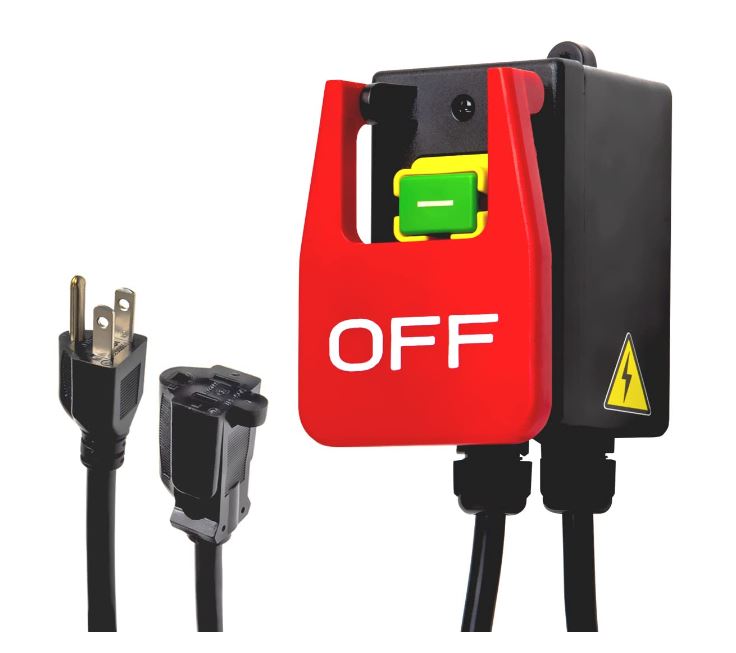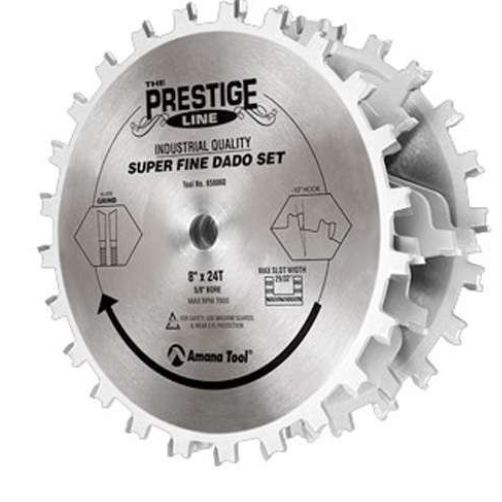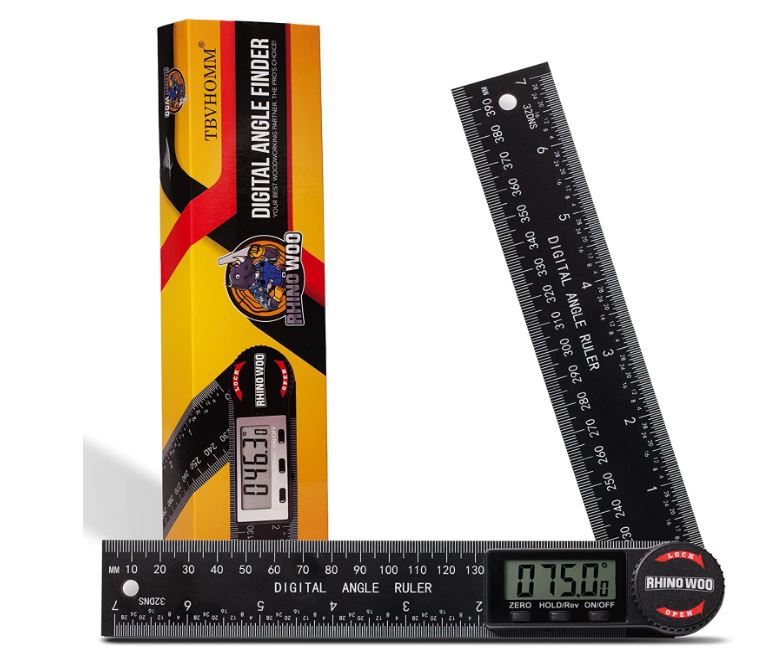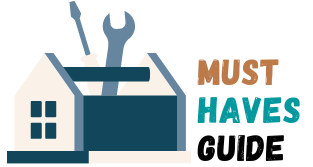Once you’ve bought a new table saw, the next step is to find the most needed accessories for your table saw. Although current-generation table saws come with every accessory you might need for chopping different projects, it’s better to have these accessories as a spare in your workshop.
Unlock the full potential of your table saw with these must-have accessories! From precision blades to easy-to-use jigs, these tools will take your woodworking to the next level. Get ready to make perfect cuts and smooth finishes every time with our top picks
Must-Have Accessories For Table Saw
Safety Power Switch

A safety power switch, also known as a “kill switch,” is a safety feature found on some table saws that allows the user to quickly and easily turn off the power to the saw in case of an emergency.
This switch is typically located near the operator and can be triggered by a variety of means, such as a foot pedal or a pull cord.
The purpose of the safety power switch is to help prevent accidents by quickly shutting off the saw in case of a problem, such as a kickback or a jammed blade.
Zero-Clearance Insert
A zero-clearance insert is a device that is used in a table saw to reduce the size of the opening in the saw’s table around the blade.

The insert is typically made of a hard, durable material like plastic or metal and is custom-fit to the shape of the saw blade.
The purpose of the zero-clearance insert is to prevent small offcuts of wood from getting caught in the larger opening around the blade, which can cause the wood to bind, kick back, or even cause injury to the operator.
Additionally, Zero-Clearance Inserts help to minimize the amount of tear-out that occurs on the bottom of a workpiece caused by the blade exiting the workpiece. It also provides a cleaner and more accurate cut by reducing the space the blade can move around.
Push Sticks And Push Blocks
Push sticks and push blocks are safety devices that are used in a table saw to push a workpiece through the saw blade. They are used when cutting small or narrow pieces of wood that cannot be safely pushed through the saw with the operator’s hands.
Push sticks have a handle on one end and a flat or V-shaped end on the other end that is used to push the workpiece through the saw blade.
Push blocks, on the other hand, are thicker and have a handle on one end and a flat or contoured surface on the other end that rests against the workpiece. They are typically used for larger, thicker workpieces.
Both devices are designed to keep the operator’s hands away from the saw blade and to provide better control over the workpiece while it is being cut.
They help to reduce the risk of kickback and injury to the operator by providing a safe and secure way to hold and guide the workpiece while it is being cut.
Also, Learn About: Uses of A Table Saw
Featherboard
A featherboard is a safety device that is used in a table saw to hold the workpiece against the saw’s fence, providing consistent and uniform pressure to the workpiece as it is being cut.

It is typically made of a hard, durable material like plastic or metal and has a series of “fingers” or “feathers” that are pressed against the workpiece, holding it securely in place.
Featherboards are commonly used in conjunction with a push stick or push block to provide an extra measure of safety and control while cutting narrow or small workpieces.
They help to reduce the risk of kickback and injury by keeping the workpiece pressed firmly against the fence and by guiding it smoothly through the saw blade.
Featherboards can be mounted on the saw’s table, on the fence, in the front or rear of the blade, and they can be adjusted to fit the thickness of the workpiece.
Some featherboards have spring-loaded mechanisms that can be adjusted to the desired pressure. They can be used with a variety of different table saws including contractor saws, cabinet saws, and portable saws.
Dado Blade Stack
A dado blade stack is a specialized cutting tool that is used in a table saw to create grooves or “dadoes” in a workpiece. The dado blade stack is essentially a set of two or more blades that are stacked together on the saw’s arbor. This stack of blades is wider than a regular saw blade, allowing it to cut a wider groove in the workpiece.

Dado blade stacks are used for a variety of different woodworking applications, including creating grooves for joining wood pieces, such as making a dado joint for shelves, making grooves for inlay, or creating decorative edge profiles.
They are particularly useful for creating precise, clean cuts in hardwood, plywood, and other materials.
The dado blade stack is typically adjustable, which allows the user to change the width of the groove by adding or removing chippers, which are thin blades that are used to adjust the width of the cut. The dado blade stack is also adjustable for its height, this way it can be set to make a perfect fit for the material being cut.
It’s important to note that using a dado blade stack requires specific precautions, as it can be dangerous if not used properly. It is important to use the proper guards, set up the saw and the blades correctly, use push sticks, feather boards and other safety devices, and follow the manufacturer’s instructions.
Angle Gauge
An angle gauge, also known as a protractor, is a tool used in a table saw to measure and set angles for cutting. It is typically a small, compact tool that attaches to the saw blade or the saw’s fence and allows the user to easily and accurately set the angle of the cut.
Angle gauges are used to make precise angled cuts such as bevels, chamfers and compound angles. They can be used to set the angle of the saw blade or to set the angle of the fence. Some angle gauges are also designed to be used with a miter gauge to make angled crosscut.
Angle gauges can be digital or analogue. The analogue angle gauge is usually a protractor with a vernier scale, this way the user can read the angle with a high degree of precision. Some digital angle gauges have a built-in inclinometer that allows the user to take precise measurements with the push of a button.
Having an angle gauge in your table saw accessories can make a big difference in your work, especially when you are working on projects that require precision-angled cuts. It can help you to achieve accurate cuts, reduce waste and increase the quality of your work.
Also Learn About: Basics of a Table Saw
Adjustable Link Belt
An adjustable link belt is a type of belt that is used to drive the arbor of a table saw. It is a flexible belt made up of a series of interlocking links that can be easily adjusted to fit the specific size of the saw’s arbor.
The adjustable link belt allows the user to replace the belt without having to remove the saw’s motor, which can save time and effort. It also allows for easy tension adjustment, this way the belt can be adjusted to run at the correct tension for optimal performance.
Adjustable link belts are often used as a replacement for the original belt that comes with the saw. They can also be used to upgrade an older saw, or to improve the performance of a new saw. They can be used with a variety of different table saws including contractor saws, cabinet saws, and portable saws.
Adjustable link belts can be made from a variety of materials, including rubber, polyurethane and neoprene, which have different characteristics and can be suitable for different types of work. They are also available in different widths and lengths to fit a variety of different saws.
Aftermarket Miter Gauge
An aftermarket miter gauge is a tool that is used in a table saw to make precise angled cuts, such as crosscuts and miter cuts. It is an accessory that can be purchased separately from the table saw and can be used to replace or upgrade the miter gauge that comes with the saw.

Aftermarket miter gauges can offer a variety of features that may not be found on a standard miter gauge.
Some of these features include improved accuracy, greater adjustability, better locking systems, and the use of a digital readout. They can also be used to expand the capabilities of a table saw, such as making angled cuts, bevels and compound cuts.
They can be made of different materials, such as aluminium, steel and wood, which can affect their durability and accuracy. Some aftermarket miter gauges also have features such as a laser guide, which can help to improve the accuracy of cuts.
When purchasing an aftermarket miter gauge, it’s important to ensure that it is compatible with your table saw and that it has the features that you need for your specific project. It’s also important to read reviews, check the specs and compare the different models before making a purchase.
Crosscut Sled
A crosscut sled is a jig that is used in a table saw to make precise crosscuts. It is a sled that attaches to the saw’s table and has a miter gauge that slides along a guide rail, allowing the user to make accurate cuts at a variety of angles.
A typical crosscut sled consists of a base, a fence and a miter gauge. The base sits on the table saw’s surface and provides a stable platform for the sled to slide on. The fence attaches to the base and can be adjusted to the desired angle. The miter gauge attaches to the sled and is used to guide the workpiece as it is being cut.
Crosscut sleds are particularly useful for making precise cuts on large workpieces, such as sheets of plywood or long boards. They can also be used to make angled crosscuts, such as for making picture frames or crown molding. They are also very useful for repetitive cuts, as they can ensure a perfect 90-degree angle every time.
Crosscut sleds can be made from a variety of materials, including wood, aluminum, and plastic. They can also be purchased pre-made or built as a DIY project. It’s important to ensure that the sled is stable, square and slide smoothly on the table saw surface, to ensure accurate cuts and safety.
Bottom Line
We hope by using these accessories, you will unlock the true potential of your table saw. If you want to upgrade your table saw, then prefer getting any of these for your workshop.

Meet Max, the founder and lead writer of our home improvement blog. He is a seasoned home renovation and design expert with over 8 years of experience in the industry.
Max has a passion for creating beautiful and functional living spaces and is dedicated to helping homeowners and DIY enthusiasts achieve their home improvement goals. He has worked on a wide range of projects, from small updates to full-scale renovations, and has a wealth of knowledge and experience to share.
As an avid DIYer, Max understands the challenges and rewards of tackling a home improvement project and enjoys sharing his tips, tricks and insights to make the process as easy and enjoyable as possible. In his free time, Max can be found working on his own home renovation projects, reading design blogs and magazines, and travelling to explore new design trends.
Max is excited to share his knowledge and experience with you and hopes to inspire and empower you to take on your next home improvement project with confidence. Follow Max on LinkedIn for more inspiration and expert advice.


